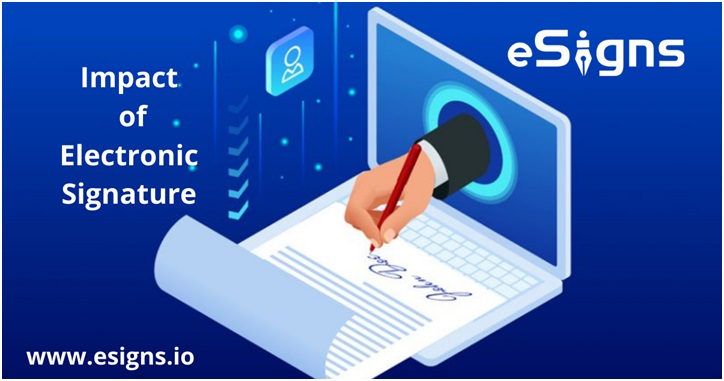What is the Impact of Electronic Signature on the US Economy?
The global electronic signature market grew from $3 billion in 2021 to $4.05 billion in 2022.
The projections state that the global digital signature market would reach $35.03 billion by 2029 at a CARG of 36.01%. 2020 had a record growth of 34.4%, thanks to the global coronavirus pandemic, which eventually declined as the intensity of the virus spread decreased.
The global spending on digital transformation was $608.72 billion in 2021, and it would reach $723.77bilions by 2022. According to market predictions, spending on digital technologies in the US alone will be $7 trillion, growing at a CARG of 18% from 2020 to 2023. Companies great rush to digital adoption was due to the considerable shift in consumer behavior.
Amid forced shutdowns and physical distancing sanctions, consumers relied on online buying and the Companies have reciprocated with 3D or 4D embedded virtual technologies to display products online where consumers can feel and experience the product on display. Conversational commerce technologies like chatbots have started engaging customers throughout the shopping journey.
Reasons for Growing Significance for Electronic Signature
From consumer electronics to grocery, customers made a beeline to online platforms to make a purchase. Customers making purchasing decisions online would like to pay from the same website without shifting between the platforms. The companies have reciprocated with the same speed to meet the customer expectations.
Customers at present can review a product online, feel and experience its quality virtually, and compare prices before they make a purchasing decision. The global coronavirus pandemic has accelerated the digital transformation in unprecedented ways as a result of growing concerns about customer privacy and safety. Increased cyber-attacks have resulted in enacting cybersecurity laws to protect sensitive data related to their digital transactions to ensure customer safety.
Primary Growth Engines of the eSignature Market in the US
The Federal Government was the key driver of the electronic signature market in the U. S followed by technological innovations and industry adoption of this novice technology.
On 21st August 2021, the US Senators introduced a bill titled ‘Digital Authenticity for Court Orders Act of 2021’ to prevent fraud and bogus documents in the courts.
The intention was to provide authentic, tamper-proof, and secured delivery of documents to the court to ensure transparency and justice.
Subsequent Technological Innovations and Growth
By February 2021, a Glasgow-based software company called Videosign established a lab that allows users to upload documents for authentication and electronic signature. The company has developed a facial recognition tool to facilitate remote witnessing for signing contracts and legal documents. By November 2021, RentTango, a rental property marketing and leasing company has demonstrated the corporate world on how to create automated workflows to sign contracts and deals and ways to comply with lease preparation and execution.
Major Industry Wise Electronic Signature Adoptions
Banks and financial sector industries, including the insurance companies, are the earliest adopters after the legal firms. While the government departments are the initial patrons of this software, education, healthcare, energy sectors like oil and natural gas companies, logistics providers, transport companies, military and Défense sector, telecommunications, real estate, IT, and manufacturing companies are the key adopters of the electronic signature software in the USA.
Exponential eCommerce Growth
There was a 45% growth in the US eCommerce sales in 2020, which declined to 34.6% by 2022 at $357.36billion. Consumers and companies relied on digital platforms to buy and sell products and services during the Corona-related market shutdown.
The US consumers have spent $1.221 trillion in the 2021 holiday season, out of which eCommerce seized a 10.4% of the market share, equal to $204.20 billion. In 2022, the holiday sales are likely to reach $1.262 trillion, where eCommerce is expected to seize $235.86 billion.
Banks, companies, and financial institutions have automated workflow to ensure transparency, efficiency, and customer safety. Automation of workflow helped the banks, onboard customers, online and allowed consumers to fill out digital loan forms, and individuals made investments virtually. Legislation to sign a document electronically helped to protect sensitive customer information like the bank account numbers, credit card, and debit card details, social security numbers, and income sources.
Remote Working
From the first quarter of 2020, when the global coronavirus was in its initial stage, 30% of the workforce started working remotely. At present, companies have hastened the digital transformation so that the remote working trend will continue for a few more years, even after the retreat of the pandemic.
The HR departments are one of the earliest adopters of digital technologies like the electronic signature platforms embedded with digital management systems.
Digitization of the workflow has helped companies identify new talents, segregate and pre-screening candidates, schedule interviews, employee onboarding, and upskill the new joiners on virtual mode. According to an Upwork survey, one in every fourth employee was working remotely in 2021, and 36.2 million American workforces will be working remotely by 2025, which is 22% of the American workforce.
Growing Number of Gen Z and Millennial Adopters
By 2022, 20% of the US population, equal to 68.2 million teens, tweens, and the young adults have adopted digital technologies in the US. These mobile-first, digital natives are the primary drivers of electronic transactions and premium electronic signature users.
Gen Z is spending more than 8 hours online, and 32% of the Gen Z ers use smartphones, and 48% of them are making an online purchase using mobiles, whose. income will be $33 trillion by 2030, with a tremendous spending power by 2031.
Digital adoption is equally encouraging among millennials. Millennials have integrated digital transactions into their buying and purchasing behavior and 85.9% of millennials in the US were digital buyers in 2020. During the pandemic, Gen X and baby Boomers have equally embarked online for making purchasing decisions on healthcare, insurance, and Consumer Package Goods.
How do the customers view Cyber Fraud and Security?
More than 2 out of 5 customers in an eMarkeeters’ survey in the US have reported actual or suspected fraud on their bank accounts. One out of every five mobile banking users has cited fraud prevention as the reason for switching over to a bank that ensures cybersecurity.
Final Thoughts
The electronic signature tool has transformed the way companies work and operate in the US. Companies are allocating vast budgets for building digital infrastructure. While the data centers, broadband networks, and telecommunications towers are part of the core digital infrastructure, Advanced digital infrastructure building is gaining momentum in the US.
Digital asset building, including cryptocurrencies, has surpassed a $3 trillion market cap in USA in November 2021. The federal government has allotted a budget of $58.44 million exclusively, to build digital infrastructure to meet civilian information needs.
This gesture demonstrates the growing significance of digital technologies in the US, where the electronic signature will be part of this scenario, providing essential privacy, data safety, and compliance with regional and local laws.



